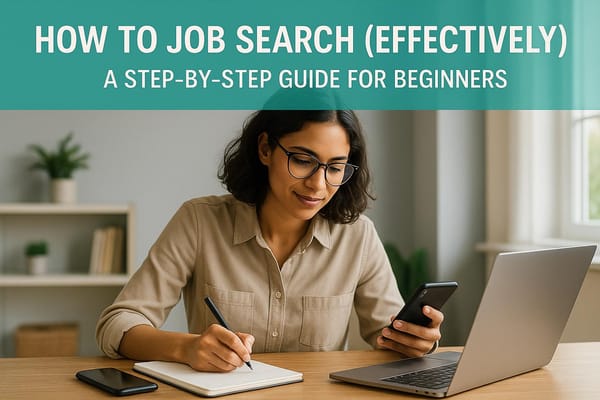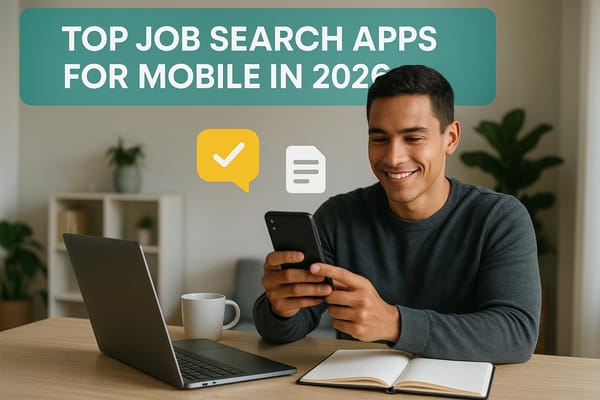AI Tools for Fixing Resume Gaps
AI tools can effectively address resume gaps by reframing employment history, optimizing for ATS, and tailoring application materials for job seekers.
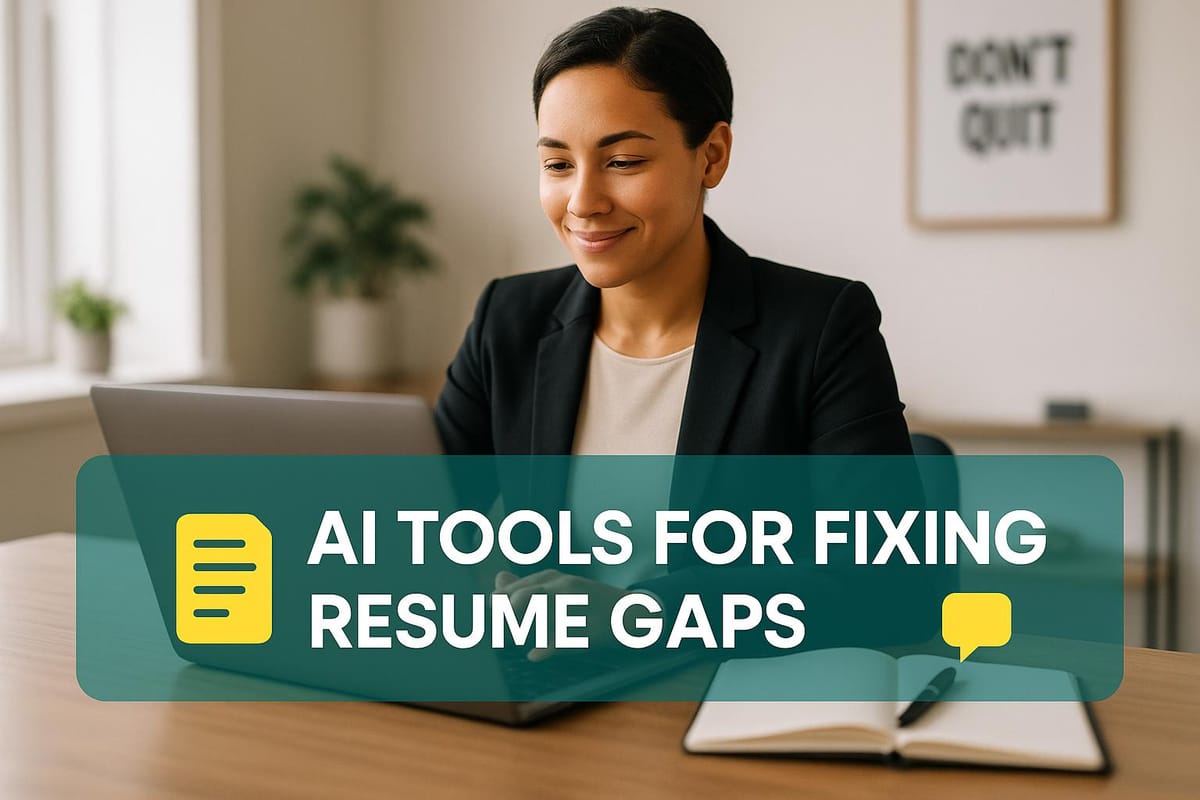
AI tools can help you address resume gaps by reframing periods of unemployment, optimizing your resume for Applicant Tracking Systems (ATS), and tailoring your application materials for specific jobs. Platforms like Scale.jobs, Rezi, and Jobscan use AI to suggest content, improve formatting, and integrate keywords that hiring managers and ATS systems prioritize.
Key Takeaways:
- Why Resume Gaps Matter: Gaps in work history can reduce callback rates, especially if left unexplained. Employers worry about skill loss, motivation, and reliability.
- AI Solutions: Tools like Scale.jobs rewrite gaps as skill-building or professional development periods, ensuring resumes are ATS-friendly and appealing to recruiters.
- Customization: AI can create tailored resumes and cover letters, explaining gaps professionally while highlighting relevant skills.
- Top Tools: Scale.jobs combines AI with human expertise, offering personalized gap explanations, ATS optimization, and job search support.
Quick Comparison of AI Tools:
| Tool | Gap-Fixing Features | ATS Optimization | Pricing Model | Human Support |
|---|---|---|---|---|
| Rezi | AI content suggestions | Strong | $29/month | No |
| Jobscan | Keyword optimization | Excellent | $49.95/month | No |
| Find My Profession | Professional writing, AI review | Good | Per project | Yes (writers) |
| Scale.jobs | AI + human-crafted content | Excellent | Free software, $9/month | Human Assistants |
Scale.jobs stands out by offering a mix of AI and human expertise, ensuring resumes are polished and tailored for both ATS systems and human reviewers. For $9/month, you get gap explanations, ATS compliance checks, and job search support, saving time and improving your chances of landing interviews.
How Do AI Resume Builders Handle Employment Gaps? - Job Success Network
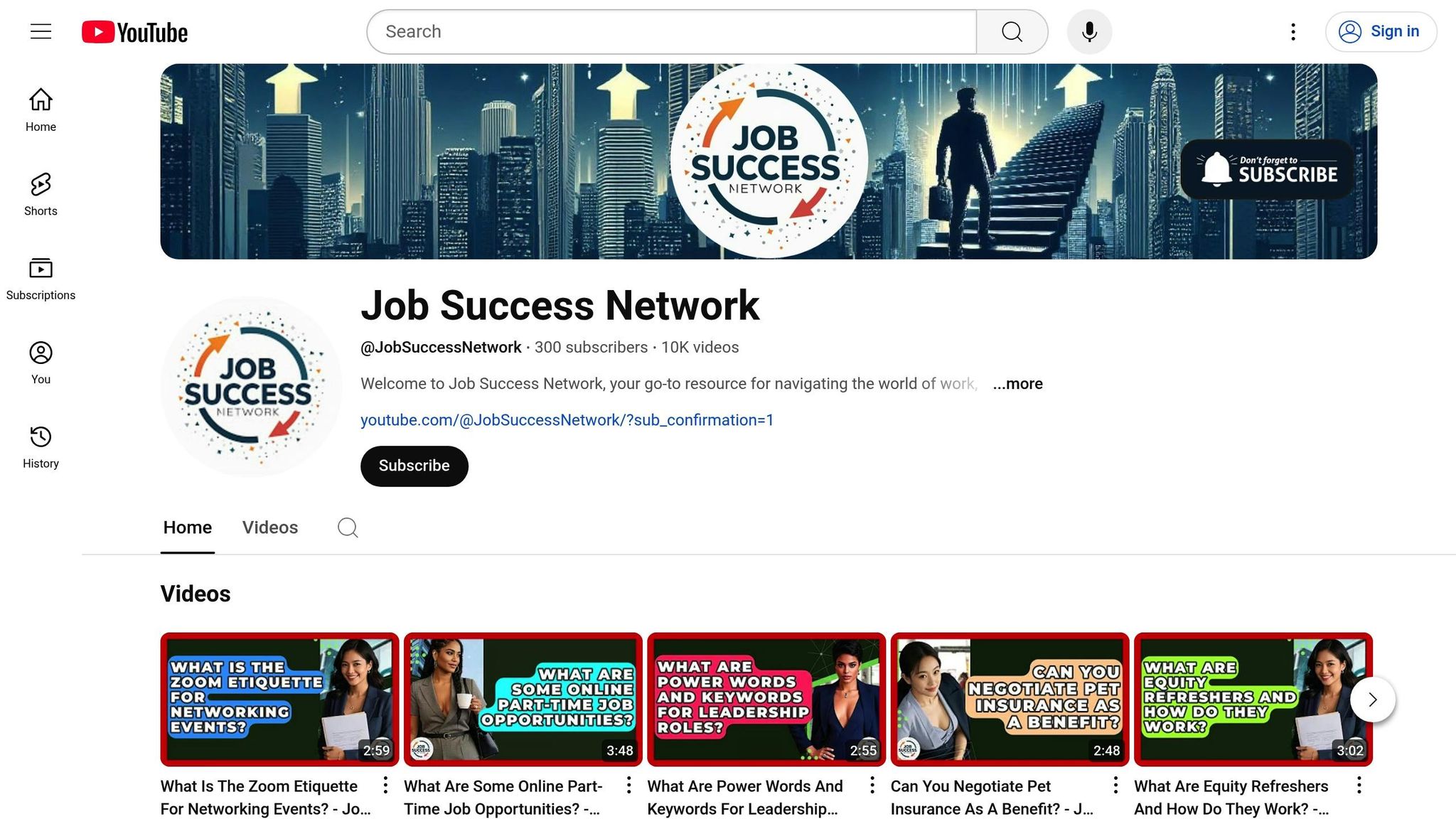
What Are Resume Gaps and Why They Matter
A resume gap refers to any period of unemployment lasting more than a few months. While shorter breaks between jobs are often seen as routine transitions, longer gaps - especially those exceeding six months - can raise concerns for hiring managers. These concerns typically revolve around questions about your dedication, skills, and how prepared you are to re-enter the workforce. In highly competitive job markets, where employers have many qualified candidates to choose from, these gaps can stand out even more.
Common Reasons for Resume Gaps
There are many reasons someone might have gaps in their employment history. Layoffs or company downsizing are common, particularly during economic slumps or industry shifts. Another frequent cause is family caregiving responsibilities. Whether it’s caring for children, aging parents, or relatives with health challenges, these gaps often reflect personal priorities rather than a lack of work ethic.
Some people take intentional breaks for self-improvement, such as pursuing advanced degrees, certifications, or shifting to a new career path. For international job seekers, visa issues can lead to unplanned employment gaps during transitions in work authorization.
Health challenges, whether physical or mental, may also result in extended time away from work. Additionally, some individuals step away to focus on personal projects, entrepreneurial ventures, or to reassess their career direction.
How Employers and ATS Systems View Gaps
Employers and automated systems approach resume gaps differently. Human recruiters and hiring managers typically understand that life events can interrupt careers. However, they still evaluate gaps carefully to ensure they don’t signal a lack of commitment or outdated skills.
"Hiring managers and recruiters are human, and they understand that things happen to all of us in life. Sometimes, situations come up that are more important than working nonstop for 50 hours a week for 30 years. So, honesty is the best policy." - Tammy Homegardner, Forbes Councils Member
Applicant Tracking Systems (ATS), on the other hand, are far less forgiving. These systems, used by 99% of Fortune 500 companies and 75% of employers in the U.S., rely on algorithms to scan resumes for specific criteria. They don’t account for personal circumstances, and gaps in employment can be flagged as potential issues.
The numbers illustrate just how widespread ATS usage is: 63% of all employers rely on these systems, with that figure jumping to 69% among large companies with over 1,000 employees. Additionally, more than 90% of employers use ATS software to filter or rank resumes before they’re ever reviewed by a human.
ATS systems often flag resumes with gaps as incomplete or problematic. Recruiters depend on details such as job titles, start and end dates, and continuous work history to assess candidates. Missing months or years can result in your resume being filtered out before it reaches a human reviewer.
These systems also prioritize specific criteria. For example, 99.7% of recruiters use keyword filters, while others focus on skills (76.4%), education (59.7%), job titles (55.3%), certifications (50.6%), years of experience (44.3%), and location (43.4%). Gaps can disrupt the flow of your work history, making it harder for your resume to pass these automated screenings.
Hiring managers also consider the timing and length of unemployment. They’re looking for evidence that you’ve stayed engaged with your field, kept your skills sharp, and remain dedicated to professional growth. Gaps might raise questions about whether you’ve kept up with industry trends or maintained the motivation to contribute meaningfully.
Recognizing these challenges is the first step toward understanding how AI can help address resume gaps and improve your chances of securing interviews.
How AI Tools Address Resume Gaps
AI tools have become a game-changer for tackling resume gaps, offering more than just cosmetic fixes. They provide strategies that appeal to both human recruiters and Applicant Tracking Systems (ATS), ensuring your resume is polished and impactful.
Rewriting Gaps with AI Assistance
Modern AI tools are adept at turning resume gaps into opportunities to showcase growth. Instead of leaving blank spaces, these tools help you present periods of unemployment as times of skill-building or personal development.
Take tools like Rezi, for example. They analyze your history and recommend specific wording to highlight activities during gaps. If you took online courses, the tool might suggest phrases like "Advanced Professional Development" or "Specialized Training Period" rather than simply noting the dates. AI tools also help uncover transferable skills from activities like volunteering, freelancing, or caregiving. For instance, time spent caring for a family member could be reframed as "Family Care Management – Coordinated healthcare logistics, managed complex schedules, and developed crisis management skills", showcasing your organizational and problem-solving abilities.
Meanwhile, Scale.jobs' AI Assistant Pro takes gap rewriting to the next level by tailoring resumes for each job application. It analyzes job descriptions and suggests explanations for gaps that align with the employer’s needs. This ensures that any periods of unemployment are framed professionally and don’t detract from your qualifications. By blending thoughtful explanations with ATS-friendly language, these tools help keep your resume competitive.
Making Resumes ATS-Friendly
AI tools don’t just stop at rewriting gaps - they also optimize your resume for ATS systems, which are used by many employers to filter applicants. Resumes with gaps can sometimes face challenges in these systems, but AI tools have developed clever ways to navigate them.
One key strategy is ensuring your resume uses ATS-friendly formatting. AI tools structure resumes with clear headings, consistent date formats, and the right file types to avoid technical issues. They also focus on keyword integration, analyzing job descriptions and weaving relevant terms into your resume - even in sections addressing employment gaps. This ensures that your explanations not only look professional but also help improve your resume’s keyword alignment.
AI systems also refine the chronological flow of your resume, making sure it complies with ATS requirements while maintaining transparency about your career timeline. For example, Scale.jobs offers a free ATS compliance check through its resume builder. This feature pinpoints potential issues and provides actionable suggestions to enhance your resume’s performance, ensuring that gap explanations fit seamlessly into the overall design.
Customizing Resumes and Cover Letters
Tailoring your application materials is crucial, and AI tools excel at creating customized resumes and cover letters that turn gaps into strengths. These tools craft job-specific documents that address gaps while emphasizing your qualifications for the role.
When it comes to cover letters, AI tools shine by crafting personalized messages that acknowledge gaps without dwelling on them. Instead, they quickly pivot to highlight your enthusiasm and key skills, keeping the focus on what makes you a strong candidate. For example, a cover letter might briefly mention a caregiving period before transitioning to discuss how the experience enhanced your time management and organizational skills.
AI tools also adapt the tone and presentation of gap explanations based on the industry. In more traditional fields, detailed explanations might be preferred, while creative industries could frame gaps as opportunities for skill development or artistic exploration. Scale.jobs' single-click AI customization ensures that resumes and cover letters are tailored to each job, maintaining consistency across documents while saving you time.
Top AI Tools for Fixing Resume Gaps
The rise of AI-powered resume tools has brought a wave of platforms claiming to revolutionize your job search. But when it comes to effectively addressing resume gaps, not all tools are up to the task. Among the many options, platforms like Rezi, Jobscan, and Find My Profession have gained popularity. However, Scale.jobs stands out by blending AI technology with human expertise, offering a more well-rounded solution for job seekers. To choose the right tool for your needs, it’s essential to understand what each platform brings to the table.
Feature Comparison of Leading AI Resume Tools
When it comes to fixing resume gaps, each tool takes a slightly different approach. Here’s a closer look at how they stack up:
- Rezi: This platform focuses on AI-generated content suggestions, providing real-time feedback and scoring resumes based on 23 key factors. It’s particularly effective for creating targeted bullet points and strategically addressing employment gaps through keyword optimization.
- Jobscan: Known for its ATS (Applicant Tracking System) optimization, Jobscan is designed to help resumes pass automated screening systems. While it excels in keyword and formatting guidance, it offers limited tools for crafting content that explains gaps.
- Find My Profession: This service combines AI technology with professional resume writers to create personalized resumes. While its hybrid approach offers strong gap explanations, its pricing varies based on the level of service required, as it operates on a per-project basis.
Here’s a quick comparison of these tools:
| Tool | Gap-Fixing Features | ATS Optimization | Pricing Model | Human Support |
|---|---|---|---|---|
| Rezi | AI content suggestions, real-time feedback | Strong | $29/month | No |
| Jobscan | Keyword optimization, limited gap content | Excellent | $49.95/month | No |
| Find My Profession | Professional writing, AI review | Good | Per project | Yes (writers) |
| Scale.jobs | AI + human-crafted content, full job search support | Excellent | Free software, $9/month AI, flat-fee human | Human Virtual Assistants |
Now, let’s dive into why Scale.jobs stands out as the preferred choice.
Why Scale.jobs Works Better
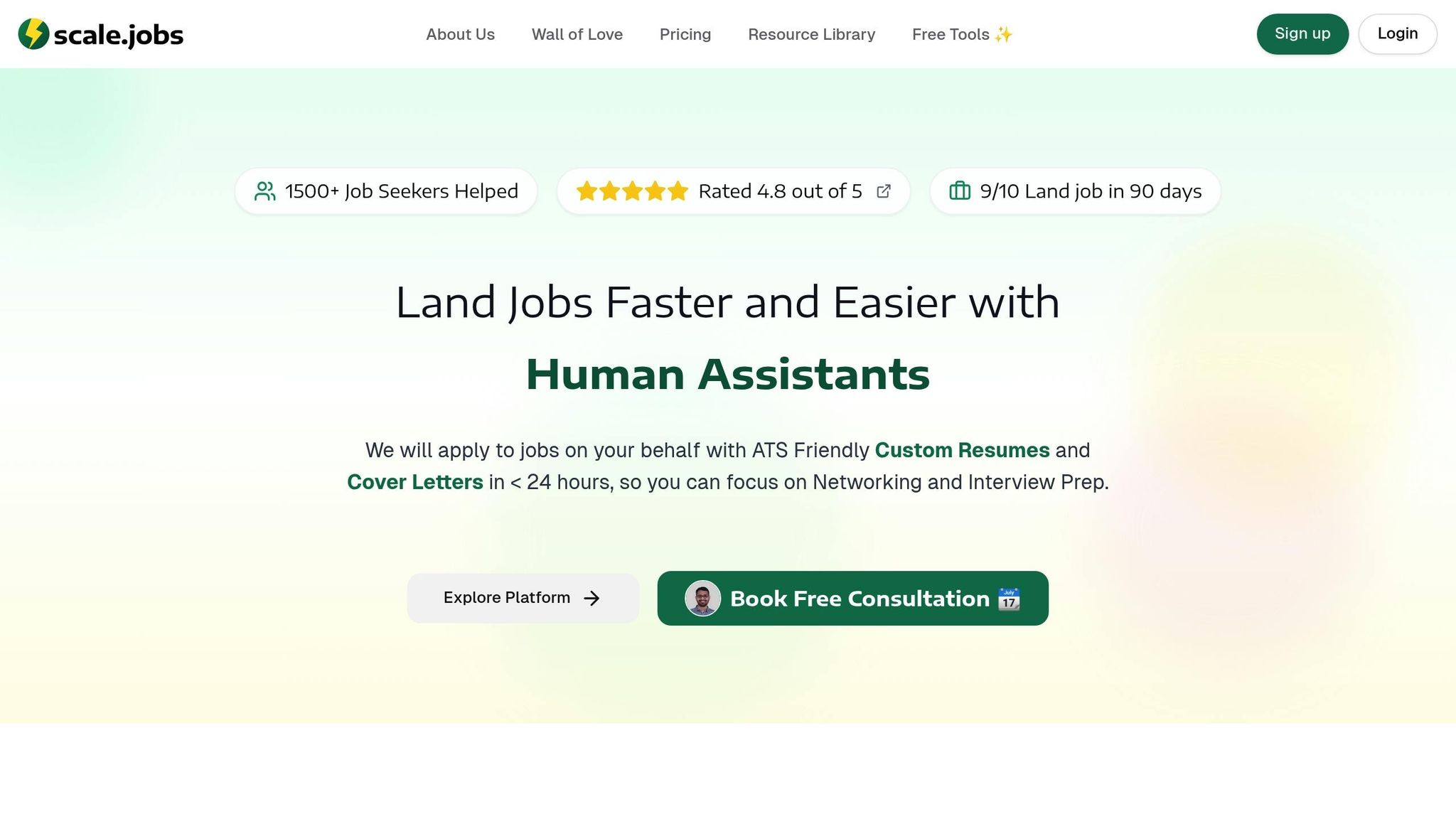
Addressing resume gaps and navigating ATS filters requires more than just automation - it demands a personal touch. Scale.jobs combines advanced AI tools with human virtual assistants to deliver a well-rounded solution.
Scale.jobs vs. Rezi: The Human Edge
While Rezi offers strong AI-powered suggestions, its capabilities stop there. Scale.jobs takes it further by integrating human virtual assistants who craft personalized gap explanations tailored to your industry and career history. This combination ensures your resume feels genuine and relevant to recruiters.
Scale.jobs vs. Jobscan: More Than Optimization
Jobscan is a powerhouse for ATS optimization, but it doesn’t offer much help with personalized gap-fixing content. Scale.jobs matches Jobscan’s ATS strengths through its free resume builder while adding customized gap explanations and full job search support. Plus, Scale.jobs’ transparent flat-fee pricing eliminates the need for recurring subscriptions, and its real-time WhatsApp updates keep you informed every step of the way.
Scale.jobs vs. Find My Profession: All-in-One Job Search Support
Find My Profession focuses on professional resume writing, but Scale.jobs goes beyond that. It offers end-to-end job search management, including tailored cover letters, application tracking, and even interview preparation. For job seekers dealing with complex challenges like career transitions or visa requirements, Scale.jobs provides a more complete solution.
What truly sets Scale.jobs apart is its commitment to transparency and results. With proof-of-work screenshots, real-time updates, and detailed reporting, you’ll always know where you stand. Whether it’s building ATS-compliant resumes, crafting compelling cover letters, or managing your entire application process, Scale.jobs ensures your job search is both efficient and effective.
Step-by-Step Guide: Fix Resume Gaps with AI
You can tackle resume gaps by using AI to spot issues, apply tailored solutions, and ensure your resume impresses both hiring managers and applicant tracking systems (ATS). Here’s how to handle it step by step.
Upload and Review Your Resume
Start by uploading your resume to an AI-powered tool designed to analyze and improve it. These platforms scan your document to identify gaps, missing skills, and weak descriptions. They also provide feedback to help you refine formatting and integrate the right keywords.
High-quality AI tools go beyond flagging gaps - they suggest ways to address them. For example, if there’s a six-month gap in your work history, the tool might recommend framing freelance work, volunteer experience, or skill-building activities to fill that space. Additionally, you'll receive tips for keyword optimization and formatting adjustments to improve your resume's performance in ATS systems.
"The trick to AI utilization for job seekers is to be great prompt writers... Submitting generic résumés is a thing of the past! Learning prompt writing skills will become critical to successful applications and getting that first live interview scheduled." - Alexander-Ali Dalipi, HR1Systems, LLC
AI tools often work best when you engage with them actively. If the initial feedback seems too vague or generic, provide more details about your industry or target role. Follow-up prompts can unlock more tailored recommendations, helping you prepare a resume that stands out.
Once you’ve reviewed the AI feedback, it’s time to put the suggestions into action.
Apply AI Suggestions to Fix Gaps
Take the AI’s advice and focus on showcasing training, projects, or skills developed during employment gaps. The goal isn’t to hide the gaps but to highlight how you used that time productively.
For instance, if you took time off for personal reasons, reframe it professionally. Label it as "Family Care Management" and list skills like project management, budgeting, or organization. If you were between jobs, describe freelance projects, certifications, or volunteer work in professional terms. AI tools can help you phrase these experiences effectively.
"ChatGPT responses often need to be refined, meaning that you should give it follow-up prompts or ask it additional questions to get the type of information you need or want." - Keith Spencer, FlexJobs Career Expert
Be sure to quantify your accomplishments. Instead of saying "took online courses", you could write, "Completed 40+ hours of professional development in data analysis, earning certifications in Excel and SQL." This approach shifts the focus from the gap itself to your initiative and growth.
For a more polished result, consider combining AI tools with expert services.
Use Scale.jobs' Complete Service
Scale.jobs offers a combination of AI-driven suggestions and human expertise to address resume gaps effectively. After using AI to revise your resume, their human assistants step in to refine it further - ensuring explanations are tailored and every detail is aligned with industry expectations.
Their AI Assistant Pro plan ($9/month) provides unlimited customized resumes and cover letters, allowing you to adapt your applications for different roles. This is especially useful since employers often interpret gaps differently depending on their industry and company culture.
What makes Scale.jobs stand out is their Human Assistant Services, where trained professionals collaborate with AI to craft personalized narratives around your employment gaps. These experts understand industry nuances and create explanations that feel authentic to recruiters.
The service also includes real-time WhatsApp updates and proof-of-work screenshots, giving you transparency into how your gaps are being addressed. You can monitor their progress and offer feedback to ensure your applications meet your expectations.
"AI is an aid, not a crutch, and candidates should always use their voice and personal experiences in their job search." - Tammy Harper, CAI
Conclusion: Fix Resume Gaps with AI and Human Help
Modern tools are changing the game when it comes to addressing resume gaps. By combining AI-driven ATS optimization with personalized content suggestions, these platforms help job seekers explain employment breaks in a professional and polished way. They not only pinpoint weak areas in your resume but also offer actionable recommendations to strengthen your overall narrative.
The real magic happens when AI and human expertise work together. AI can propose ways to reframe gaps, such as presenting time off as "Professional Development" or "Family Care Management." Meanwhile, human professionals bring industry-specific knowledge to the table, crafting stories that resonate with hiring managers and align with specific career goals.
One standout platform in this space is Scale.jobs, which offers a hybrid approach. For just $9/month, their AI tools provide detailed analysis, while their flat-fee human assistance ensures your resume is polished and ready for submission - without the hassle of ongoing subscriptions. This approach can save job seekers over 20 hours a week, all while maintaining high-quality results. By blending the speed and precision of AI with the nuanced touch of human expertise, Scale.jobs helps transform employment gaps into narratives of growth and resilience.
Whether you're a recent graduate, navigating a layoff, or making a career pivot, addressing resume gaps requires a thoughtful mix of AI efficiency and human insight. The goal isn’t just to fill in the blanks but to craft a story that highlights growth and adaptability.
Start by using AI tools to identify areas that need improvement, then refine your message with human input. This dual strategy ensures your resume not only passes ATS filters but also stands out to hiring managers, giving you a stronger shot at landing interviews despite any career breaks.
FAQs
How can AI tools like Scale.jobs and Rezi help address resume gaps to attract employers?
AI tools like Scale.jobs and Rezi are game changers for job seekers looking to address gaps in their resumes. Instead of letting these periods raise concerns, these tools help reframe them by focusing on skills gained, continuous learning efforts, or any relevant experiences during that time. This approach turns what might seem like a drawback into an opportunity to showcase growth and adaptability.
On top of that, these tools are designed to optimize resumes for ATS (Applicant Tracking System) filters, increasing the chances of your application landing in front of a hiring manager. By emphasizing transferable skills, achievements, and tailoring the narrative for each specific role, these AI tools help candidates create polished, standout profiles that resonate with employers.
How do AI tools help optimize resumes for Applicant Tracking Systems (ATS)?
AI tools make it easier to tailor resumes for Applicant Tracking Systems (ATS) by focusing on keyword matching, streamlined formatting, and ATS-compatible templates. These tools analyze job descriptions to pinpoint important keywords and help you integrate them effectively into your resume. They also suggest avoiding overly complex layouts, like those with images or intricate designs, which can confuse ATS software.
Some of these tools even go a step further by evaluating your resume against specific ATS algorithms. This helps identify gaps in skills or qualifications, ensuring your resume aligns closely with the job’s requirements. By leveraging these strategies, you can boost your chances of passing ATS filters and getting your resume in front of actual human recruiters.
How can AI tools help tailor resumes and cover letters to match specific job requirements?
AI tools have made it easier than ever to create resumes and cover letters that match specific job requirements. By analyzing job descriptions, these tools can pinpoint important skills, qualifications, and keywords. Then, they use this information to craft tailored, ATS-friendly documents designed to pass automated screening systems.
Take platforms like scale.jobs, for example. With just one click, they can produce resumes and cover letters that emphasize the most relevant experiences and skills for a particular role. This level of personalization helps job seekers make a stronger impression in competitive job markets while saving both time and effort.

